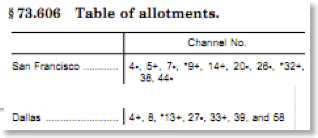"Transmitters Don't Use Up Spectrum, Receivers Do!"

The title of this post is an old truism in spectrum policy. It is also something your blogger never heard until he started working at FCC, so it is probably not discussed much outside some groups in FCC and NTIA. The basic point is shown in the the old analog TV allotment table (47 C.F.R. 73.606) which shows what TV channels could be used in each city for NTSC. Excerpts for SF and Dallas are shown below:
Note the UHF channels (>14) . For SF, the city that CTIA is boycotting, the channels are 14, 20, 26, 32, 38, and 44 - the same analog channels as the Washington DC area. For Dallas they include 27, 33,and 39. See the pattern? In a given city, the UHF TV channels were spaced 6 channels apart. (Someone might point out that Washington has channel 22, between channels 20 and 26. True in a way, but it is not in Washington, it is actually in Annapolis.)
Each analog TV channel took one 6 MHz channel. The increment of 6 was to protect the mediocre TV receivers that were expected when UHF TV was authorized in 1952 “Sixth Report and Order”. They are a direct result of the channel separations mandated by “UHF taboos” in Table II of 73.698 which in turn resulted from assumptions of the ability of TV receivers to reject nearby signals and limits on how much they would unintentionally radiate internal signals that might interfere with neighbor’s reception. Again, these were all 1952 estimates - certainly based on earlier data since the FCC decision was made in 1952. A sad observation on the state of spectrum management at FCC in the past is that FCC never had the resources and courage to change this misuse of UHF spectrum as radio technology was revolutionized during the period 1952 - 1986. I cut off at 1986 because that was around the time that that HDTV came to center stage and DTV started looking feasible. Only the arrival of DTV finally removed the limitation on using only every 6th UHF channel. It is clear, to your blogger at least, that technology was available by the 1970s to have receivers with more robust interference immunity to allow more intense use of UHF TV even without DTV, yet the FCC did not have the political will to do so as it would have infuriated the TV interests that dominated FCC spectrum policy deliberations at that time.
12. Include receiver tolerances in regulation (either through (1) additional incentives, (2) mandates, or (3) some combination of incentives and mandates) to be used until can migrate to “interference temperature” regulatory scheme and to be used for the long term where use of interference temperature would be inapplicable; e.g., for systems in which licensees do not have control over receivers.
14. Issue Notice of Inquiry to characterize current and future receiver environments and to explore issues to consider, such as, performance parameters and protection for legacy receivers.
A key problem in spectrum innovation is that endless FCC deliberations discourage investment in wireless R&D and a key issue in such endless deliberations is differing expectations about receiver performance by incumbents and potential entrants. (“Harmful interference” is also an ill defined issue at FCC that extends deliberations and is usually related to receiver performance.)
Both the lengthly and inconclusive AWS-3 controversy and the current GPS/LightSquared controversy (not to mention the PCS H block issue) have at their root the issue of receiver performance expectation. Reasonable people could disagree about what are appropriate expectations for T-Mobile’s cell phone receivers - in the AWS-3 case - and GPS receivers - in the LightSquared case - with respect to adjacent band signal rejection. As in the case of harmful interference, NTIA and FCC need to develop a way to resolve receiver expectation issues in a timely way if they want to encourage technical innovation and the capital formation that is an integral part of it. Such resolutions need not make every party - or even any party - happy, but they are essential to maintain US leadership in both wireless technology and wireless services. The above SPTF recommendations would be a good place to start!





![Validate my RSS feed [Valid RSS]](valid-rss-rogers.png)

